The Chairman’s Corner – Captain Robert Newberry
Time For Fairness and Justice on Cleaning Up the Chesapeake Bay – 20/02/22
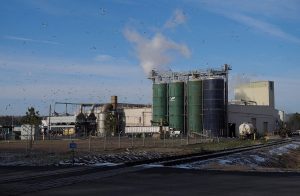 Two sacred guiding principles in our society are equal treatment under the law and justice delayed is justice denied.Recent events indicate how in one case of environmental protection action these principles have been followed to the letter and in another case of environmental protection inaction these principles have been completely ignored.
Two sacred guiding principles in our society are equal treatment under the law and justice delayed is justice denied.Recent events indicate how in one case of environmental protection action these principles have been followed to the letter and in another case of environmental protection inaction these principles have been completely ignored.
The first case is a recent consent decree reached between the State Attorney General, the Maryland Department of the Environment (MDE), and Valley Proteins. Valley Proteins is a business operating a waste processing plant for the poultry industry on Maryland’s Eastern Shore. The consent decree resulted from violations of state water quality regulations and requirements. Key elements of the consent decree are:
• $540,000 in fines.• Additional fines if Valley Proteins fails to meet future deadlines going forward on scheduled compliance requirements.• Valley Proteins to pay the legal fees and related costs for expenses incurred by those who joined in the legal action by the attorney general and MDE.
At the Delmarva Fisheries Association (DFA), we support efforts to monitor and punish those whose actions hurt water quality in the Bay watershed. We do so regardless of who does it. We applaud recent actions in Virginia where the Chesapeake Bay Foundation, a self-appointed champion for the Bay, was charged, fined, and banned from Virginia after dumping toxic materials as part of an oyster reef replenishment project they were paid by grants to implement.The second case where equal treatment under the law and justice delayed is justice denied has been the long-term failure of state regulators to take timely and meaningful action on a critical problem in the upper Chesapeake Bay. That problem is the decades-long discharge of untreated wastewater from two mismanaged wastewater treatment plants owned and operated by the City of Baltimore. One is the Back River wastewater treatment plant and the other is the Patapsco wastewater treatment plant. These discharges have had and continue to have devastating impacts on water quality in the upper Bay. While the MDE recently took over the operations of the Back River Wastewater Treatment Plant, the duration of that takeover and the outcome of improved operations there are still to be determined.
Why the difference in awareness and action? It certainly is not due to groups like the Delmarva Fisheries Association not sounding an alarm on this dumping.
The answer is simple and deeply troubling.
Valley Proteins is a business, not a government operation. I am not suggesting they did not violate the law. They did. But when they did, they were punished relatively quickly and severely for their violations with stiff penalties.By contrast, the City of Baltimore has repeatedly ignored the alarms over problems at both wastewater treatment plants. To make matters worse, they spend millions of dollars, allegedly, to upgrade and improve operations at both plants with NO measurable results.
WHY?
Government regulators, politicians, and environment advocacy organizations have learned it is easy to go after low hanging fruit. It takes courage, tenacity, and a commitment to do the right thing, regardless of political considerations.Now more than ever, the Bay is at a tipping point. Steps need to be taken NOW to address the serious and ongoing issues at the Back River and Patapsco wastewater treatment plants in Baltimore.
Time and energy does not need to be spent on election year partisan grandstanding with recent articles and photo ops about the “great progress” on cleaning up the Bay on the 50th anniversary of the enactment of the Federal Clean Water Act.It was once observed that when all is said and done a lot is said and very little gets done.
There is one way and one way only to get things done on real solutions to water quality in the Chesapeake Bay. Voters throughout Maryland need to hold elected and appointed officials at all levels accountable for their lack of interest in and actions on the Bay.This is an election year, a time when candidates for office at all levels are acutely sensitive to voters. If you care about the Bay, demand action from your elected officials. Do not dwell on the past. It is more important to ask them what they plan to do if elected. Most importantly, hold them accountable post- election to do the right thing and by honoring the principles of equal treatment under the law and justice delayed is justice denied.
Do it before it is too late.
A Great Season and Good News, but Issues Remain 04-22-22
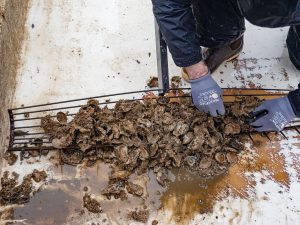 Now that the oyster season is over and we are heading into the crabbing season, the numbers of harvested oysters already exceeding 500,000 bushels is a very good thing. Before all the work is done, and before the tickets are counted, we should have around 550 thousand bushels of oysters for the season. Not bad, considering we have caught more oysters this year then we have in 39 years. The last time we caught this many oysters we had 50% more bottom, higher bushel limits, and more fishermen participating in the oyster season. So, this year we caught more oysters, with lower bushel limits, with less fishermen, on less bottom, and with less effort to acquire over 500,000 bushels. This equals one thing: a sustainable fishery. Any person that denies that needs to go get a checkup from the neck up. Next season will be an even better season followed by at least three more good years.
Now that the oyster season is over and we are heading into the crabbing season, the numbers of harvested oysters already exceeding 500,000 bushels is a very good thing. Before all the work is done, and before the tickets are counted, we should have around 550 thousand bushels of oysters for the season. Not bad, considering we have caught more oysters this year then we have in 39 years. The last time we caught this many oysters we had 50% more bottom, higher bushel limits, and more fishermen participating in the oyster season. So, this year we caught more oysters, with lower bushel limits, with less fishermen, on less bottom, and with less effort to acquire over 500,000 bushels. This equals one thing: a sustainable fishery. Any person that denies that needs to go get a checkup from the neck up. Next season will be an even better season followed by at least three more good years.
With all this good news, one more good thing, the legislative session is finally over! Yahoo! This was by far one of the worst years I have ever seen in Annapolis in all my 30+ years over there. One of the main issues encountered was with Senate Bill 830. That bill was presented by the infamous Senator Elfreth from Anne Arundel County, and Chairman of the Chesapeake Bay Commission. At the first exposure to this bill, it appeared as if a bunch of high school kids had put this bill together for a project in an American government class. And it never changed all the way through. This bill was like a cricket bouncing around in a microwave! Even delegates and senators that supposedly represent those in the seafood industry said it was a good bill. BS! The industry unanimously opposed the bill from both the Western and Eastern shore, even though some people who claimed to represent the industry supported the bill.
There are even people who claim to represent the industry who made comments directly to a senator saying the seafood industry supported the bill and to move forward. Oh, believe me, this fool got an earful from many watermen. Certain delegates even had to cry in their soup to their fellow politicians at the last minute, suck it up and say that they can’t vote for it because the industry does not support the bill.
The problem is, these politicians knew it all along, but denied the power of the industry when they are united! The bottom line is, these politicians over in Annapolis need to understand one simple thing: there is one industry, with one voice, and they better start listening, for it is an election year! These politicians better remember this too: there is one thing they need and that we don’t, and that’s votes!
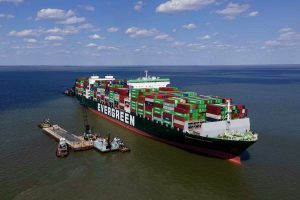 To change gears a little bit, we’ve got a major problem in the Chesapeake Bay! Between the “EVER STUCK” that was aground for over a month and caused major impact to the bottom on a natural oyster bed, the wastewater treatment plants in the Patapsco and Back Rivers being a total failure and killing the Bay, and the Conowingo Dam spewing garbage and mass amounts of nutrients into the Bay, things don’t look too good for the health of the Bay. Here’s the problem: we don’t want to be reactive to an ongoing situation, but rather we are trying to be proactive. However, these environmental groups have turned such a blind eye to these problems that the people who can solve them are being convinced they are not big issues! That’s right, the Chesapeake Bay Foundation referred to the Conowingo Dam problem as a “red herring” and have not done anything to address the pollution coming from the Patapsco River or the Back River for the past 10 years. Now, suddenly, they are all involved and concerned. Those of us in the industry really wish that the public would recognize these people for the morons and fools that they are and stop funding them, or at least put their money to good work and not in the pockets of idiots. I hate to be so harsh, but the facts are facts, and after dealing with these people this entire session and over the years, one has finally got to conclude that these people are nothing but total fools in everything they do. Enough of the doom and gloom. Fortunately, the ship was refloated (on Easter Sunday) and hopefully the wastewater treatment plants will clean up their act and stop breaking the law, and we will finally get something done at the Conowingo Dam.
To change gears a little bit, we’ve got a major problem in the Chesapeake Bay! Between the “EVER STUCK” that was aground for over a month and caused major impact to the bottom on a natural oyster bed, the wastewater treatment plants in the Patapsco and Back Rivers being a total failure and killing the Bay, and the Conowingo Dam spewing garbage and mass amounts of nutrients into the Bay, things don’t look too good for the health of the Bay. Here’s the problem: we don’t want to be reactive to an ongoing situation, but rather we are trying to be proactive. However, these environmental groups have turned such a blind eye to these problems that the people who can solve them are being convinced they are not big issues! That’s right, the Chesapeake Bay Foundation referred to the Conowingo Dam problem as a “red herring” and have not done anything to address the pollution coming from the Patapsco River or the Back River for the past 10 years. Now, suddenly, they are all involved and concerned. Those of us in the industry really wish that the public would recognize these people for the morons and fools that they are and stop funding them, or at least put their money to good work and not in the pockets of idiots. I hate to be so harsh, but the facts are facts, and after dealing with these people this entire session and over the years, one has finally got to conclude that these people are nothing but total fools in everything they do. Enough of the doom and gloom. Fortunately, the ship was refloated (on Easter Sunday) and hopefully the wastewater treatment plants will clean up their act and stop breaking the law, and we will finally get something done at the Conowingo Dam.
Looks like we’re up for a good crabbing season, and a good striped bass season. We do have the upcoming ASMFC leaving addressing amendment 7 on striped bass, and this will be an absolute jewel to deal with coming up next month. To all of our members at DFA, have a great spring and get ready for a profitable summer! God bless all of you and thank you for your support.
Continuing the Fight 10-29-2021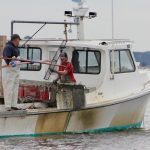
Well, I know it’s been a long time since I posted a Chairman’s Corner, but things have been crazy busy. To start, we had a great board meeting and dinner at Annie’s Paramount Steak & Seafood House, which was well attended. Thank you for coming and I hope you enjoyed the food.
Moving forward, DFA has been extremely busy with issues concerning the seafood industry in Maryland. Being that oyster season is now in full swing, we have been working with the Department of Natural Resources on issues concerning the culling of oysters and what can be considered for the 5% container. As the law states now, any oyster, 1” or larger, attached to a legal oyster of 3”, has to be removed COMPLETELY from the 3” oyster. This creates a problem: NRP officers are putting 3” oysters in the cup when it is holding a 1” or larger oyster. This will be addressed and should be straightened out by the end of October. NRP said no tickets will be issued concerning this matter until the regulation has been ironed out.
Last week, the Atlantic States Marine Fisheries Council met concerning issues with menhaden and striped bass. On the menhaden side, they are trying to create a new fishery in New England by depleting the Mid-Atlantic fishery. Things don’t seem to be moving as fast as they would like though. It appears that nothing will be done in the near future, and we should hear something by 2023. Our opinion at DFA is that Maryland should not give up its quota because whatever is not caught, swims free.Therefore, those fish shouldn’t be subtracted from the whole biomass of fish.
The striped-bass issues got a little bit crazy! Once again, the CCA and their buddies tried to place a moratorium on striped bass, which was completely removed from any consideration–a plus for Maryland. Other concerns were about reallocation and what we can do about establishing the exact number of fish in the Bay. The proverbial can was kicked down the road because a CCA representative from Maryland attempted to pin recreational dead discards onto commercial fishing! But it backfired. The ASMFC understood this. Other individuals tried to tie the decline, or so-called decline, of striped bass in the Bay to the lack of menhaden as their primary forage fish. I don’t think this gained any traction either: The ones that are moving forward with the issue of the menhaden bass are not scientists, and some of the issues they addressed are absolutely insane. We believe that the council sees this also. The striped bass fishery in Maryland, both commercial and recreational, more than likely will remain the same for at least two more years, unless the recreational “representatives” assume some sort of responsibility for what they catch. Excellent work done by DNR’s representatives on the council. I would like to extend kudos to Mike Louise and Lynn Feigley, in particular.
On the issues concerning the Oyster Advisory Committee and the oyster management plan, this is enough to drive the average man crazy (and it seems to be doing a good job of it at this point). With all the information being supplied by scientists, model scenarios, and the constant nitpicking of the environmental groups, hopefully things will move forward and be ready by December for the general assembly.
One of the most important issues that has arisen out of the OAC is the need for oyster shell as substrate to build a better population of oysters in the Bay. Recently, the DNR has come out with the 5-year sanctuary study and, believe it or not, under the best bars scenario, Talbot County has 7 of the top 10 most productive bars in the entire Bay. In that top 10 are also bars in Dorchester and Somerset counties. The worst bar of all is Man-O-War Shoals. It had the worst ranking of any of the bars in the Chesapeake Bay! Being that this is 150 million bushels of shell that can be used to restore 15,000 acres of bottom and is fully approved by every known agency on Earth for the permit, it is still being held up at the Board of Public Works. Somebody has convinced legislatures that it is the most important bar in the upper Bay. What in the hell are they talking about? One county is holding this up, and this is Baltimore County Watermen’s group. They do not even have a sustainable oyster industry in that county and have very few, if any, active oystermen participating in the fishery. The comptroller of Maryland, Peter Franchot, is the deciding vote out of the three on this matter, and he has been the holdup all along. With the recent statements made by him of wanting to put a moratorium on all water filtering bivalves and phasing out the commercial oyster fishery to replace with aquaculture, his vote appeared to be a no. But as of late, he realizes there is a lack of shell in the Bay to sustain our oyster industry and has even admitted as much to certain other watermen’s groups. What this gentleman needs to do is get his head out of the mud and realize there’s 150 million bushels of shell sitting readily available. The problem is, Baltimore County Watermen’s Association does not want that area touched! And for what reason? We would like to know. I think the watermen of Baltimore County should wake up and contribute to the industry throughout the state and become the heroes and not be referred to as the zero! I know this makes some people mad, but with the situation that we’re in right now with these oysters and missing 3 years of excellent bed set, these gentlemen need to step up and work with us and stop being so selfish. We wish there were a way that we could work with these gentlemen, even though they are not willing to negotiate. Maybe the money they receive for planting oysters should be removed by the state. Would this wake them up? It’s too bad it has to come to this, but desperate times call for desperate measures. I don’t know a single county in the state that objects to the dredging of Man-O-War Shoals other than Baltimore, and doesn’t that seem a little bit ridiculous?
Moving forward, I would like to wish all of you a happy holiday season and hope everybody is staying healthy and safe. DFA will be working very hard this session on several issues, and also will be working hard to see that those participating in the seafood industry in Maryland will be able to continue to work without repeatedly getting kicked around, as they have been for many years. Environmental groups have our industry in their crosshairs. It is time to stand up and educate them with simple and basic truths–empirical evidence of what is happening. The untruths they tell are dangerous–used to propagate their agenda and keep the money flowing. We need to stand unified against this force, and to speak as one voice. God bless all of you for the hard work you do, and, believe me, it does not go unnoticed and unappreciated. Thank you.
Captain Robert Newberry
Chairman
Delmarva Fisheries Association Inc.

Chairman’s Corner Update 4-13-2020
Dwindling Supply of Watermen Provide Strong Response 9-24-2019
 Recently the Editorial Board of the Baltimore Sun weighed in on the issue of oyster management in the Chesapeake Bay, simultaneously calling hard-working men and women of the seafood industry stupid and suggesting the Department of Natural Resources (DNR) is out to destroy the oyster. As Chairman of Delmarva Fisheries Association (DFA), I took issue with both of these positions, and several others blithely laid out for the members of Maryland’s General Assembly to devour with their oyster shooters and clam strips. It does nothing to represent our side, the side that’s busy trying to make a living ensuring city folks have fresh, local seafood for their fundraising fêtes.
Recently the Editorial Board of the Baltimore Sun weighed in on the issue of oyster management in the Chesapeake Bay, simultaneously calling hard-working men and women of the seafood industry stupid and suggesting the Department of Natural Resources (DNR) is out to destroy the oyster. As Chairman of Delmarva Fisheries Association (DFA), I took issue with both of these positions, and several others blithely laid out for the members of Maryland’s General Assembly to devour with their oyster shooters and clam strips. It does nothing to represent our side, the side that’s busy trying to make a living ensuring city folks have fresh, local seafood for their fundraising fêtes.
 After more than 30 months of Oyster Advisory Commission (OAC) meetings, the regulations are in place for this upcoming season. DNR worked with stakeholders from the legislative, scientific, academic, seafood, business and nonprofit community to arrive at a plan to act now to use a multi-pronged strategy to increase the oyster biomass. Our DFA members proposed several ways to reduce harvest pressure, one of many stressors to the oyster population, as did others. Ultimately DNR came up with a plan for the coming season that left no one 100% satisfied. It’s called compromise. Given that most of the special interest groups involved in the conversation were pushing for a moratorium on harvest, we are relieved that DNR did not completely cave to those who seem more focused on destroying our livelihoods than using methods like the Seed and Shell Replenishment program, that worked for 40+ years, to bring the oyster back.
After more than 30 months of Oyster Advisory Commission (OAC) meetings, the regulations are in place for this upcoming season. DNR worked with stakeholders from the legislative, scientific, academic, seafood, business and nonprofit community to arrive at a plan to act now to use a multi-pronged strategy to increase the oyster biomass. Our DFA members proposed several ways to reduce harvest pressure, one of many stressors to the oyster population, as did others. Ultimately DNR came up with a plan for the coming season that left no one 100% satisfied. It’s called compromise. Given that most of the special interest groups involved in the conversation were pushing for a moratorium on harvest, we are relieved that DNR did not completely cave to those who seem more focused on destroying our livelihoods than using methods like the Seed and Shell Replenishment program, that worked for 40+ years, to bring the oyster back.
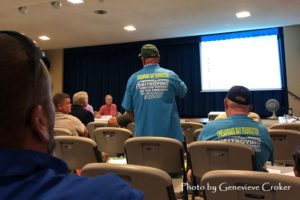 One reason that these special interest groups have such a powerful voice is because they speak in unison…something watermen in the Chesapeake Bay have not been very successful at doing. This dissension in our own ranks allows our opponents to tell the General Assembly, and the general public, that we don’t know what we want or what’s “good” for us. Now is the time to band together and commit to acting in the best interests of our industry and, of course, the natural marine resources upon which we depend. We need to focus our message on several issues but the most urgent is the lack of shell. For the new Oyster Management Plan (OMP) to work, we must push the Board of Public Works (BPW) to take affirmative action on the pending permit to dredge for buried shell at Man O’War (MOW) Shoals. We all know that one of the reasons the sanctuaries aren’t performing like the Bay Foundation and others promised is because they’re not being managed properly…dumping construction rubble and hatchery spat, with it’s high post-lab mortality rate, on to the bottom and then walking away isn’t the right way forward.
One reason that these special interest groups have such a powerful voice is because they speak in unison…something watermen in the Chesapeake Bay have not been very successful at doing. This dissension in our own ranks allows our opponents to tell the General Assembly, and the general public, that we don’t know what we want or what’s “good” for us. Now is the time to band together and commit to acting in the best interests of our industry and, of course, the natural marine resources upon which we depend. We need to focus our message on several issues but the most urgent is the lack of shell. For the new Oyster Management Plan (OMP) to work, we must push the Board of Public Works (BPW) to take affirmative action on the pending permit to dredge for buried shell at Man O’War (MOW) Shoals. We all know that one of the reasons the sanctuaries aren’t performing like the Bay Foundation and others promised is because they’re not being managed properly…dumping construction rubble and hatchery spat, with it’s high post-lab mortality rate, on to the bottom and then walking away isn’t the right way forward.
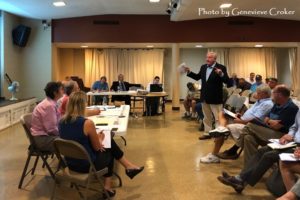 At the latest meeting of the OAC, Kent County Commissioner Ronald H. Fithian, who is a DFA Board Member as well as an OAC Member, introduced a resolution urging action on MOW Shoals. Though the vote ended in a deadlock, we still believe in the measure and to that end are circulating the resolution to gather industry signatures and present it to the BPW. We hope you will sign it or send your own letter urging the BPW to take action. Together we can combat the misleading language and the skewed science the special interest groups are feeding to our elected officials and advocate for solutions that will allow the Bay’s iconic bivalve to flourish once again. To paraphrase the Native American proverb, as a single twig we are weak, but as a bundle we’re unbreakable.
At the latest meeting of the OAC, Kent County Commissioner Ronald H. Fithian, who is a DFA Board Member as well as an OAC Member, introduced a resolution urging action on MOW Shoals. Though the vote ended in a deadlock, we still believe in the measure and to that end are circulating the resolution to gather industry signatures and present it to the BPW. We hope you will sign it or send your own letter urging the BPW to take action. Together we can combat the misleading language and the skewed science the special interest groups are feeding to our elected officials and advocate for solutions that will allow the Bay’s iconic bivalve to flourish once again. To paraphrase the Native American proverb, as a single twig we are weak, but as a bundle we’re unbreakable.
The Oyster’s Future Looking Grim 5-29-2019
On Friday, May 24th, Governor Larry Hogan vetoed SB 830 / HB 720, frequently dubbed the “OysterFutures” bill because it claims to be based on the OysterFutures Workgroup model. Ironic given that if certain special interest groups truly valued that process, we 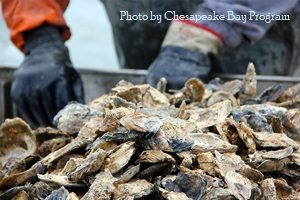 wouldn’t need this bill. In fact, this is a hearty kick in the teeth to those who participated in the previous Workgroup and to the Maryland Department of Natural Resources, who used the suggestions that the Workgroup had consensus around to create a Fishery Management Plan (FMP) for Oysters. To quote the Governor, these special interest groups are making an “end run” around the process that didn’t produce the outcome they have been gunning for for decades – a replacement of the wild fishery with aquaculture.
wouldn’t need this bill. In fact, this is a hearty kick in the teeth to those who participated in the previous Workgroup and to the Maryland Department of Natural Resources, who used the suggestions that the Workgroup had consensus around to create a Fishery Management Plan (FMP) for Oysters. To quote the Governor, these special interest groups are making an “end run” around the process that didn’t produce the outcome they have been gunning for for decades – a replacement of the wild fishery with aquaculture.
Following the veto, several media outlets have been twisting the Governor’s stance despite his letter explaining the decision being clear and to the point. Not only does it undermine the hard work over the last several years to comply with one statutory hurdle after another, it’s also in direct violation of the Maryland Open Meetings Act. There are 14 reasons why a closed meeting can be convened and, “work[ing] out their differences with candid, private talk,” ain’t one! Open debate is proper and transparent – what are these folks hiding that the public can’t know about? It is quite possible that this bill will face a court challenge if the Governor’s veto is overridden.
What we see with this bill is a freshman Senator and the groups who have co-opted the “environmentalist” label throwing another wrench in a system that has been burdened by delay after delay. Not satisfied with the results of the survey they requested (remember how the report said there was no evidence sanctuaries were increasing the stock?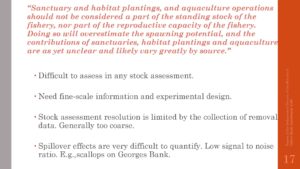 ), these groups spent the 2019 legislative session scrambling to find a new way to push their tired old theme: aquaculture is the future, the watermen’s way of life is antiquated. As they work to ram this bill down our throats, they’ve reached out to select watermen to discuss how they can make things better for us. Well, we may be simple folk, but we’re not stupid. How can we possibly trust these groups after they’ve spent 30+ years trying to put us out of business? I know for certain it’s not going to be through secretive meetings and backroom deals. Trust and transparency are a major factor in working through difficult problems. Currently, we trust the Bay Foundation about as far as we can throw the Queen Mary, and their transparency is like a concrete curtain.
), these groups spent the 2019 legislative session scrambling to find a new way to push their tired old theme: aquaculture is the future, the watermen’s way of life is antiquated. As they work to ram this bill down our throats, they’ve reached out to select watermen to discuss how they can make things better for us. Well, we may be simple folk, but we’re not stupid. How can we possibly trust these groups after they’ve spent 30+ years trying to put us out of business? I know for certain it’s not going to be through secretive meetings and backroom deals. Trust and transparency are a major factor in working through difficult problems. Currently, we trust the Bay Foundation about as far as we can throw the Queen Mary, and their transparency is like a concrete curtain.
For our part, we were encouraged to see that Governor Hogan responded to the request from DFA and many other groups to veto the “OysterFutures” bill last week. Like the Governor, we believe this bill is a slap in the face to the various stakeholders who participated in the development of DNR’s new oyster management plan and represents yet another moving of the goal post by legislators intent on destroying the public fishery. While it is likely that the veto will be overturned during the next session of the General Assembly, it is our hope that in the meantime, we can move forward with the new plan and demonstrate how a sustainable wild harvest is compatible with long-term conservation practices. While the Chesapeake Bay Foundation and their cronies chase the almighty dollar, us commercial fisherfolk will be doing the Lord’s work – using proven strategies to increase the Bay’s natural filter feeders after years of devastating illness, too much rain and the yet-to-be-properly-controlled pollution from upstream.
Misleading Marylanders about Man O’War 4-22-2019
 Recently, the Chesapeake Bay Magazine published an editorial from recreational fisherman, Captain Chris Dollar, regarding the Department of Natural Resources (DNR) application for a permit to dredge buried oyster shell at Man O’War Shoals. Given that Capt. Dollar regularly provides online tips to those who hunt fish purely for sport, we were surprised at his assertion that the Man O’War is daily crawling with boats from “as far south as Soloman’s.” Speaking for those whose livelihood depends on nature’s bounty, and who are actually in a position to observe where the weekend anglers spend their time, Man O’War has been a dud for several years; most folks look for stripers at Hodges Bar or Swan Point. In point of fact, DNR’s scientists report that careful dredging at Man O’War is likely to improve habitat for fish and crab, creating new topography that may “contribute to increases in epibenthic organisms and other organisms that occupy shell habitat and serve as forage for striped bass.”
Recently, the Chesapeake Bay Magazine published an editorial from recreational fisherman, Captain Chris Dollar, regarding the Department of Natural Resources (DNR) application for a permit to dredge buried oyster shell at Man O’War Shoals. Given that Capt. Dollar regularly provides online tips to those who hunt fish purely for sport, we were surprised at his assertion that the Man O’War is daily crawling with boats from “as far south as Soloman’s.” Speaking for those whose livelihood depends on nature’s bounty, and who are actually in a position to observe where the weekend anglers spend their time, Man O’War has been a dud for several years; most folks look for stripers at Hodges Bar or Swan Point. In point of fact, DNR’s scientists report that careful dredging at Man O’War is likely to improve habitat for fish and crab, creating new topography that may “contribute to increases in epibenthic organisms and other organisms that occupy shell habitat and serve as forage for striped bass.”
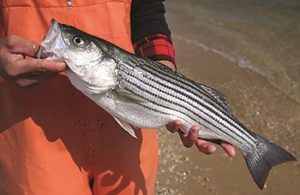 Capt. Dollar goes on to quote the Coastal Conservation Association (CCA), a group that, not incidentally, was originally formed by executives from Humble Oil, now ExxonMobil, to destroy the commercial fishery in Texas. The CCA and other special interest groups spent the 2019 legislative session furthering their agenda to phase out the public fishery here in Maryland and the three bills they pushed to ban dredging at Man O’War are an example of one of their failures, despite the time and money they poured into their lobbying efforts. Perhaps the science and facts that they were using to support the prohibition on dredging ran up against the science and facts from DNR, the Maryland Department of the Environment (MDE), the U.S. Army Corps of Engineers (USACE), the U.S. Fish and Wildlife Service (USFWS) and National Oceanic and Atmospheric Administration (NOAA)? The decision to dredge at Man O’War involved all of these agencies and more, yet somehow the General Assembly is being propped up as more capable of deciding how to handle this public natural resource.
Capt. Dollar goes on to quote the Coastal Conservation Association (CCA), a group that, not incidentally, was originally formed by executives from Humble Oil, now ExxonMobil, to destroy the commercial fishery in Texas. The CCA and other special interest groups spent the 2019 legislative session furthering their agenda to phase out the public fishery here in Maryland and the three bills they pushed to ban dredging at Man O’War are an example of one of their failures, despite the time and money they poured into their lobbying efforts. Perhaps the science and facts that they were using to support the prohibition on dredging ran up against the science and facts from DNR, the Maryland Department of the Environment (MDE), the U.S. Army Corps of Engineers (USACE), the U.S. Fish and Wildlife Service (USFWS) and National Oceanic and Atmospheric Administration (NOAA)? The decision to dredge at Man O’War involved all of these agencies and more, yet somehow the General Assembly is being propped up as more capable of deciding how to handle this public natural resource.
Other misinformation presented here and in other propaganda concerns the amount of shell to be dredged. Initially, the permit request is for approximately two (2) million bushels, which will be followed with a careful, multi-year environmental impact assessment to verify that there are no unexpected negative outcomes. If findings indicate the there are no significant adverse affects, then five years after the permit is approved, approximately three (3) million more bushels can be harvested. Any additional shell harvest, up to the 30 million bushel limit, will require new permits to be approved. However, since two, or even five, million bushels doesn’t sound alarming in a area with potentially over 100 million bushels of buried shell, the special interest groups are running with 30 million.
The opinio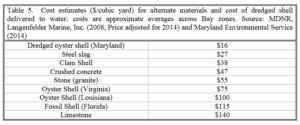 n piece wraps up by quoting Baltimore watermen’s concerns over impacts to the crab industry. In January of last year, Salisbury University released a report on the impact of Resource-Based Industries (RBI) on the Maryland economy. Their findings reveal that, “[i]n 2015, the Seafood and Aquaculture sector contributed nearly $355 million to the State economy.” And the percentage of that contribution that came from Baltimore City and Baltimore County? 1.4%. Take it from an Eastern Shore waterman, one who represents the 82.6% of that $355 million contribution that we here on the Peninsula are responsible for, when I say dredging at Man O’War will provide the wild fishery and aquaculture with much-needed shell to continue to have a thriving seafood industry at a fraction of the cost of the construction rubble these “environmental” groups are pushing as an alternative.
n piece wraps up by quoting Baltimore watermen’s concerns over impacts to the crab industry. In January of last year, Salisbury University released a report on the impact of Resource-Based Industries (RBI) on the Maryland economy. Their findings reveal that, “[i]n 2015, the Seafood and Aquaculture sector contributed nearly $355 million to the State economy.” And the percentage of that contribution that came from Baltimore City and Baltimore County? 1.4%. Take it from an Eastern Shore waterman, one who represents the 82.6% of that $355 million contribution that we here on the Peninsula are responsible for, when I say dredging at Man O’War will provide the wild fishery and aquaculture with much-needed shell to continue to have a thriving seafood industry at a fraction of the cost of the construction rubble these “environmental” groups are pushing as an alternative.
Farewell to a Beloved Brother Waterman 10-24-2018
 Last week we lost a giant in the Maryland seafood industry; Captain Calvin Kendall went to a better place on the 16th of October 2018. With his perfection of the patent tong rig, Captain Calvin was an icon in the oyster industry. He was also a life-long clammer, a commercial netter, hook-and-line fisherman, and renowned charter boat captain out of Rock Hall, Maryland. During the height of the charter boat boom, Captain Calvin operated a successful bait and tackle business that many of us remember fondly.
Last week we lost a giant in the Maryland seafood industry; Captain Calvin Kendall went to a better place on the 16th of October 2018. With his perfection of the patent tong rig, Captain Calvin was an icon in the oyster industry. He was also a life-long clammer, a commercial netter, hook-and-line fisherman, and renowned charter boat captain out of Rock Hall, Maryland. During the height of the charter boat boom, Captain Calvin operated a successful bait and tackle business that many of us remember fondly.
I love thinking about all the fun that we had getting together each morning at our round table at Pasta Plus in Rock Hall – Captain Calvin, Captain Cope Hubbard and others from the old school of watermen. It feels like all the old timers finally got called to the big Bay beyond. To Captain Calvin Kendall I say, May the wind always be at your back and may the seas always be calm in your journey ahead. God bless you, my Brother.
As the struggle for a thriving, sustainable fishery continues, the ASMFC is meeting this week in New York City. I was planning to attend until, at the last minute, the menhaden discussion was removed from the agenda. Is this because there are more menhaden now along the coast than we’ve ever seen? Even Maine had an excellent catch, aided by the 3.5 million+ pounds gifted to them by fishermen in Maryland and Virginia. We haven’t heard any thanks for parting with some of our quota, but we’re sure it’s in the mail.
In oyster news, the season has gotten off to a slow start. Due in part to the poor growth of last year’s oysters and the high mortality rate after the unseasonably heavy rains this summer, it does not look good north of the Bay Bridge. Maryland DNR is now conducting their fall oyster survey and DFA looks forward to participating in these efforts. We are especially interested in the survey results at Man O’ War Shoals. The results there will influence our pursuit of the shell dredge permit that will help us re-instate the proven, highly successful seed and shell program to re-establish the oyster population throughout the Chesapeake.
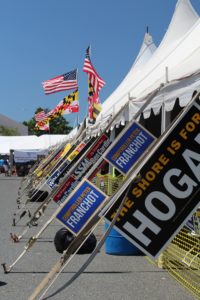 Finally, as we all well know, we have a very important election coming up for Governor of Maryland. After attending several recent events featuring Governor Hogan, I remain confident that this man does have the best interests of the seafood industry in Maryland uppermost on his agenda. We all know that he has been hamstrung in some of his efforts to help us, but his actions compared to the O’Malley Administration speak for themselves. All I can say is, when he gets into office again in November, I believe things will be better.
Finally, as we all well know, we have a very important election coming up for Governor of Maryland. After attending several recent events featuring Governor Hogan, I remain confident that this man does have the best interests of the seafood industry in Maryland uppermost on his agenda. We all know that he has been hamstrung in some of his efforts to help us, but his actions compared to the O’Malley Administration speak for themselves. All I can say is, when he gets into office again in November, I believe things will be better.
His opponent on the other hand, not only seems clueless about our industry, but is busy flying to San Francisco, California to fundraise for his campaign! Do the right thing and get out there and vote on November 6 (or vote early now!). Our livelihoods on the Bay will be strongly affected by the outcome of the gubernatorial race. Make sure you vote for the guy who remembers he’s running for Governor of the Great State of Maryland, and who spends time on the Eastern Shore even when there’s not an election on the line.
Wild-Caught Oysters are the Cornerstone of our State 9-12-2018
 With the most recent questions about the water quality of the Chesapeake Bay after unseasonably heavy rains, the recommendation of the Manokin River as the fifth Maryland tributary for oyster restoration, and the possibility of a major hurricane affecting this area, it’s been a busy couple of weeks on the Peninsula.
With the most recent questions about the water quality of the Chesapeake Bay after unseasonably heavy rains, the recommendation of the Manokin River as the fifth Maryland tributary for oyster restoration, and the possibility of a major hurricane affecting this area, it’s been a busy couple of weeks on the Peninsula.
One thing I’m currently focusing on, as a member of the Maryland Aquaculture Review Team (MART), is the issue of the oyster restoration efforts, present and future. When ENGOs originally began touting the oyster as a Bay BMP, the measurement of credit for nutrient reduction was only applicable to oysters that had been removed from the Bay and had their muscle mass weighed. I found their framing of their results confusing. They break it down to cost per pound, a smart thing to do to figure the bang for your buck. They hoped that this would benefit the burgeoning aquaculture industry and open up new funding sources. However, the flaw in their model was the fact that you had to pull the oysters out of the water in order to weigh them and get credit, which meant the nutrient reduction credits couldn’t be assigned to oysters in sanctuaries. This summer, a report was issued supposedly justifying the 23 million plus dollars spent on the Harris Creek by modeling nutrient reduction in a new way. I’m interested to delve further into this report and see how they were able to manage their calculations without using the accepted standard.
The bottom line is this: the more oysters that are put in the water, filter that water over time, and then (and here’s the important part) are harvested, thereby removing the oyster and the nutrients it has gobbled up, the better the water quality. Letting them just sit there means the nutrients are also sitting there and this ultimately affects the longevity of the bivalve in question as they are more vulnerable to disease or being smothered by silt if not managed properly through rotational harvest.
The other problem at hand is the ongoing oyster aquaculture dilemma. The aforementioned Aquaculture Review Team is doing a good job of addressing some of the issues, but a foundational element of the conflict is not being properly acknowledged. It appears that aquaculture in the State of Maryland is being promoted in order to bring about the demise of the wild harvesting commercial industry. We hear private individuals consistently say that waterman are dinosaurs, that the fishery is disappearing, and the only thing future is aquaculture for all. This is absolutely the wrong angle for these aquaculturists to take. According to the Executive Director of the East Coast Shellfish Growers Association, Bob Rheault, in his recent remarks to MART, aquaculturists should be working hand in hand with the commercial industry, and not target areas where commercial harvesting has historically been done.
Our industry is under attack. Under a previous administration our productive bottom was reduced by much more than the stated 25%. In reality it was closer to 50%. Now, those in the aquaculture business are leasing areas that not only affect oystering, but also crabbing, clamming…even the rights of riparian owners to harvest waterfowl! This is getting out of hand. In my view, we must step back and completely reevaluate the comprehensive aquaculture bill of 2010. I’m pleased that MART is meeting several more times to discuss these exact issues; however, we need to see members of the General Assembly showing up. They hold the key to the solution of this problem: protecting the rights of the citizens of Maryland to participate in the harvesting of natural resources from the Chesapeake Bay rather than focusing on the protection of private companies creating artificial oysters.
Over the past several years, the Commonwealth of Virginia has been leading the way in successful replenishment of oyster populations. And guess how they’re doing it? By implementing the exact same plan we used in Maryland for more than 40 years, even using the dredge that was created here specifically for that program. Why don’t we currently use these successful methods? Because ENGO’s lobbied to kill our seed and shell program in 2006.
I also find It shameful that some Marylanders are promoting the aquaculture industry with absolutely no consideration for the heritage represented by the commercial fishery. Take a look at the Great Seal of the State of Maryland: on the left is a plow man, more commonly known as a farmer, and on the right is a fisherman, more commonly known as a waterman. I cannot believe that so many ENGOs and aquaculturists are actually promoting the privatization and abuse of our natural resources at the cost of killing an industry upon which our great State of Maryland was founded. How can they look at that State seal and not be totally ashamed of what they’re doing? The simple answer is: money, money, money!! Stop the gravy train and watch what happens. Perhaps it’s the low cost and the lack of federal dollars to grab that’s the real issue with the Manokin River project.
We here at the Delmarva Fisheries Association look forward to working with the Department of Natural Resources over the next several years to help bring the oysters back properly. Think about it – when you build a house, you don’t hire a car salesman. When you restore oysters, you don’t hire a market analyst. Trust watermen, we live and breathe the Bay and we rely on our lifeblood being healthy!
The ‘Red Herring’ Strikes Again 7-30-2018
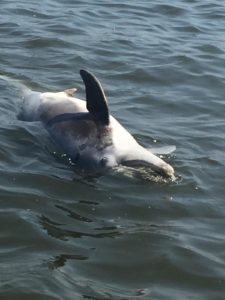 Last week’s storms have brought renewed attention to one of the biggest threats to the health of the Chesapeake Bay: the Conowingo Reservoir. For years, many environmental groups have downplayed the threat posed by the accumulated garbage behind the Conowingo Dam, calling it a “red herring” (from CBF in 2012) and pointing to farmers and watermen as the greater threat to the Bay. Denial and downplaying are becoming much harder in the face of last week’s rain and Exelon’s same old response: open the spill gates (aka flush) and dump shock loading amounts of sediment, phosphorus, nitrogen and debris into the Bay, undoing millions of dollars of restoration work in one foul blow.
Last week’s storms have brought renewed attention to one of the biggest threats to the health of the Chesapeake Bay: the Conowingo Reservoir. For years, many environmental groups have downplayed the threat posed by the accumulated garbage behind the Conowingo Dam, calling it a “red herring” (from CBF in 2012) and pointing to farmers and watermen as the greater threat to the Bay. Denial and downplaying are becoming much harder in the face of last week’s rain and Exelon’s same old response: open the spill gates (aka flush) and dump shock loading amounts of sediment, phosphorus, nitrogen and debris into the Bay, undoing millions of dollars of restoration work in one foul blow.
Governor Hogan and his Administration are stepping up to the plate and addressing this enormous problem head-on, the first Maryland Governor in recent history to do so. He has imposed conditions on the Water Quality Certification (WQC) that Exelon needs in order to renew their operating license through the Federal Energy Regulatory Commission (FERC) and invested in a pilot dredging project to explore beneficial re-use of the material sitting above the Dam. And how are some environmental groups responding? They’re suing the Administration for “not doing enough.”
What a load of hooey! All of the sudden these disturbing images of the sediment plume, the debris fouling boats, and the dead dolphins are great for fundraising and so these group are suddenly up in arms. They should have been up in arms since Hurricane Agnes or Tropical Storm Lee! Had they gotten on board then, we might already be piping that junk to Aberdeen to mitigate shore erosion or selling some of it for aggregate. Instead we’re bemoaning a new wave of havoc on the submerged aquatic grasses and the millions of baby oysters planted in the Bay over the last few weeks. This represents millions of dollars down the drain and yet somehow the prevailing sentiment is still that it’s “too expensive” to dredge above the dam. I ask you, how expensive is it to flush millions down the proverbial toilet? Because that’s what happens when Exelon opens up 17 spill gates and the water rushes through at nearly 400,000 cubic feet per second (cfs) as the USGS reported it did on July 26th.
Delmarva Fisheries Association (DFA), together with the Clean Chesapeake Coalition (CCC), has been, and will continue to be, on the forefront of addressing the Conowingo Factor. We have not waivered on our position regarding the Dam since our inception. The bottom line is that we cannot continue to sit idly by while these scouring events destroy the Bay. It must be dredged now in order to regain it’s helpful role as a trap of upstream pollutants. This is a stop-gap measure while Pennsylvania and New York work to implement needed management practices to reduce the pollution to the Susquehanna. This is not an “either/or” proposition. There is no doubt PA and NY are lagging behind pollution reduction goals. Any steps they take today will take some time to actually make an impact on the problem. Meanwhile, the Bay is bearing the brunt of decades of steps that weren’t taken and one more major storm event could set us back years, negating the positive results we’ve seen re: SAVs and oyster restoration this summer.
Will the environmental groups finally engage with us in this conversation or will they continue to pick the low-hanging fruit, cherry-picking causes whenever something disturbing enough happens that gives them a fundraising campaign image to raise more money to maintain the status quo? The hard-working watermen and many local government officials are willing to stand up and say, “Enough!” We invite the public to join us as we continue to dedicate resources to tackling the ticking time bomb at the top of the Bay, before the entire estuary is a giant dead zone and what we love so much about the Eastern Shore is permanently ruined.
A Unified Front is Needed to Represent the Commercial Industry in the Battle for the Bay 6-6-18
Recently, DFA has been closely monitoring a contentious aquaculture lease application for 14-acres in the Honga River off Wroten Island at the mouth of Wheatly Point Cove. It so happens that the lease applicants were charged with several counts of accessing the proposed lease area and setting gear before the lease was approved by DNR. After a court hearing most charges were dismissed and one charge was placed on the “Stet” (inactive) docket. This is a hand slap on the lease applicants compared to the repercussions that would result from a similar violation in the commercial oyster fishery, where such a violation by a waterman would likely result in the revocation of his license to work on the water. That doesn’t seem fair, does it? When it comes to protecting our natural resources, there should be equal enforcement.
Conflicts between private aquaculture leases and the public oyster fishery abound, especially where the private lease areas encroach upon public shellfish areas and Bay bottom where watermen and County Oyster Committees have invested in shell and/or seed. Where was the consideration and protection of the commercial fishery in the Honga River when this controversial lease application was processed? Early in the process, an organization that claims to represent commercial watermen and one that claims to represent oystermen registered protests against the lease application, but neither organization followed up with substantive arguments against the lease application and both failed to show up at the hearing before the Administrative Law Judge (ALJ) to make the case for the commercial fishery. Alone at the administrative hearing to contest the lease was the owner of Wroten Island, whose chief concerns are the adverse impacts of a water column lease and related activities on waterfowl resting areas, hunting activites and riparian habitats. With no representative of the commercial watermen at the hearing, the ALJ decided in favor of the lease applicant.
In my opinion, it is unfair to fault Maryland DNR, the Governor or any of his staff for this aquaculture lease being approved in Honga River. Yes, it’s the wrong location for a private lease – but Maryland DNR is operating inside the bounds of the law set forth by the Maryland General Assembly to promote aquaculture and private leasing throughout the Bay and its tributaries (Natural Resources Article of the Maryland Code, Title 4, Subtitle 11A). Additionally, the commercial industry (especially those organizations that claimed to represent the industry) failed in this case to represent their interests and concerns during the process allowed for challenging the lease.
Would there have been a different outcome if the watermen had been properly and fully represented in their original request to protest the lease? I say YES, because the concerns are legitimate, and the lease applicants have proven themselves to be scofflaws. It remains a mystery why two organizations that claim to represent Maryland watermen and the industry abandoned their initial protests, clearing the way for the lease to be approved.
To avoid similar situations throughout the Bay, we need to take responsibility for properly representing our interests as new lease applications are under consideration by DNR. We also need to act within the rules for protesting and challenging. At the same time, we need to be unified in advocating for changes to Maryland’s private leasing and aquaculture laws to better ensure that the rights and interests of those whose livelihoods depend on the fisheries are considered. Right now, the scales appear to be heavily weighted in favor of private leasing at the expense of the public fisheries.
Let’s stop pointing the finger at the Hogan Administration and DNR and instead find common ground so we can work together for the protection and sustainability of our Chesapeake Bay seafood industry.
Mother Nature Makes the Best Substrate and Shame on “Environmental” Groups for Suggesting Otherwise 3-5-18
After what felt like a long winter, things are finally getting wound up in the place everybody loves to be: Annapolis, Maryland. Last Tuesday, February 27, Senate Bill 926 was heard in front of the Senate Education, Health and Environmental Affairs Committee. Sponsored by Senator Steve Hershey, SB 926 will give priority to the use of natural oyster shell and prevent non-indigenous “alternative” material from being used in the Chesapeake Bay as substrate for oyster replenishment without testing. In layman’s terms: if it didn’t come out of the Bay, it shouldn’t go into the Bay.
The hearing was well-attended by representatives of both the commercial seafood industry and those purporting to be on the environmental side. While you might think that a bill of this nature would be supported by both those that rely on the Bay for their livelihood, and those that claim to want a clean Bay, you’d be wrong. The “environmental side” comprised of the Chesapeake Bay Foundation (CBF), the Coastal Conservation Association (CCA), and some other members of the latest “10 Billion Oysters Partnership” flat out oppose this bill. They seem to think dumping rock, broken up brick, ground up concrete, and assorted other junk is better than the native oyster shell that exists already. What are they thinking? In the past, some of these same groups have contested rubble landfills that are miles from the Chesapeake Bay, stating that the leaching from such rubble waste could wind up contaminating Bay waters. But when it comes to pots of grant funding tied to oyster restoration and building fake reefs in sanctuaries with taxpayer money, these groups are perfectly ok with dumping such materials directly into the Bay and its tributaries.
During the hearing, as expected, the issue of dredging shell from Man O’War Shoal in the upper Bay came up. The enormous natural oyster shell deposits at Man O’War Shoal and in other parts of the upper Bay completely undermines the manufactured “no shell available” crisis that is stoked by organizations hostile to the commercial fishery. Our panel in support of SB926 was questioned by the Vice-Chairman who cited different studies suggesting that natural shell was not the least expensive substrate of choice in oyster restoration (we explained that when the handling and transportation costs of alternative materials are considered, natural indigenous shell is the most cost-effective).
After I testified, I stayed for a few minutes and listened to the opposition’s testimony to the Senate Committee. I felt sick to my stomach as I listened to these so-called environmentalists call for a plan to dump solid waste on the bottom of the Bay as substrate for oysters. The CBF representative even stated that this junk is better than shell. A representative of Morgan State University testified that is a “myth” that oyster shell is the best substrate…ground up concrete and construction waste is better, he said. Are these people serious? We all know that oysters will strike on anything available that is hard and clean, even golf balls and spark plugs; but the watermen of Maryland have not contacted the PGA or Champion auto parts to get their waste materials to build reefs. We prefer the real thing. Oyster shell naturally occurs in the Bay for a reason. Contrary to the agenda put forth by the opposition to SB926, the designs of Mother Nature should not to be ignored, or bypassed.
Since oyster harvesting started in the 1800’s, natural shell from Maryland has been used as substrate in the industry. For 40+ years we even had a very successful program of relocating shells, in partnership with the State of Maryland. But in 2006, that replenishment program was halted by the objections of the same people who want this construction debris dumped in the Bay. In spite of the obvious lessons to be learned from the problems and controversy over the alternative substrate materials used in the Choptank River complex, they want to expand their technique of covering our Bay bottom (including viable natural oyster bars) with junk.
What’s difficult about engaging in this conversation is the awareness that common sense has been thrown out the window. Native oyster shell has been called the best substrate available by the federal government and many other organizations over the years. Yet suddenly these environmental groups are advocating for dumping waste in the water, instead of re-locating naturally occurring material. Why this change of heart? Perhaps the answer lies in donation records. Unfortunately, while organizations are required to disclose the names of their largest donors to the IRS, they can choose to redact the names from the public version of their 990. But we all know that when big money gets thrown at issues, nonprofits can be tempted to engage in mission drift. On the other hand, the watermen still fight the good fight even though we aren’t backed by deep pockets. Some of us seem to fight harder than others, and that’s because we don’t roll over to these quasi environmentalists, and we can’t be bought. Plain, simple and to the point. Stand tall and strong my brothers and sisters in the seafood industry, and hold your heads high as we press on for what’s right in the Bay…
To view Captain Rob at the Senate Hearing on SB 926, click here.
To see DFA’s written testimony in support of this bill, click here.
Menhaden Bait Fishery Gets a Boost – Facts Matter 11-15-17
This week the ASMFC Menhaden Management Board held a two-day meeting in Baltimore, Maryland to consider allocation decisions under Amendment 3. At the meeting, the Board voted 16 to 2 to adopt Option B for Ecological Reference Points (ERPs) and voted 16 to 2 to defeat Option E, which would have unfairly reallocated quotas already assigned to states. As stated by the ASMFC’s Technical Group, Option E stood the chance of wiping out the brood stock of menhaden, and yet this option was wholeheartedly supported by the CBF and the CCA – and was justly defeated. Even a last minute effort by these ENGO’s to cap the Total Allowable Catch (TAC) at 200,000 metric tons for two years was defeated by a vote of 15 to 3 – another resounding defeat for the ENGO’s committed to reducing the ranks of commercial fishermen. On Tuesday, the Board set the TAC at 216,000 metric tons – an 8℅ increase – and a Chesapeake Bay cap at 51 million pounds for the reduction fishery. That was another 15 to 3 vote. Also, 40 million pounds will be disbursed coastwise to several states. This poundage can be traded or used as necessary. Also approved was the “bycatch” allowance on menhaden for the bait industry in Maryland at 12,000 lbs per day. In all, Maryland’s bait fishery came out on top, and in great shape. More fish is what they wanted and needed, and deserved! Maryland DNR did an excellent job in helping the menhaden fishermen get more fish; which in turn will boost fishing communities and local economies.
On the other hand, the CBF and CCA took it on the chin, and deservedly so. These two organizations have constantly, over the past several years, peddled mass misinformation to the citizens of Maryland concerning menhaden. At the ASMFC meeting in Baltimore the truth (real science) was presented and the outcome was evident…A MAJOR DEFEAT OF THEIR ANTI-COMMERCIAL FISHERIES AGENDA. These groups need to stop shoveling the manure, and start being honest to their dues paying members. They and their counterparts receive millions of dollars to put good working people out of business by manufacturing deceptive environmental conditions and crises, and by convincing politicians that the way to help is with more regulations on the industries they have targeted with all the blame. People that operate this way are commonly known as charlatans. Here’s the bottom line: if we use peer-reviewed science to generate the facts, and stop politicizing our natural resources, and be honest in our agenda, we win hands down. If not, you get what happened to the ENGOs leading the charge at the ASMFC meeting in Baltimore.
Capt. Rob
CBF Movie about the “most important fish in the sea” 10-27-17
This week – on October 23rd in the evening – the Chesapeake Bay Foundation (CBF) presented a movie at the library in Chestertown called “The Most Important Fish In The Sea.” As billed, this movie is all about the importance of menhaden in the ecosystem of the bays and oceans. Most if not all the information presented in this movie is now antiquated and all the facts about menhaden have been rewritten. In attendance for the public viewing representing CBF were the organization’s Eastern Shore Director and Senior Scientist. Both of these gentlemen grossly misrepresented the facts on menhaden in the industry, used “science” that has been found to be flawed, and misrepresented many other items concerning menhaden in the Maryland waters of the Chesapeake Bay. It was evident that their reason for being there was not for protecting or cleaning up the waters of the Chesapeake Bay (remember “Save the Bay”); it was instead a promotion of CBF’s anti-commercial fishing agenda and a fundraiser for that agenda from the people in the room. During the question and comment period, Delmarva Fisheries Association made comments and ask questions refuting just about all of the statements that they had made on menhaden. They answered the questions properly and admitted that they had not been forthcoming with the facts. After DFA went toe-to-toe with the Senior Scientist and basically exposed all of his misleading comments, CBF’s Eastern Shore Director abruptly ended the question and comment period. DFA made it clear to everybody in the room that the commercial seafood industry’s position is not necessarily a bad one, and they all agreed. Several people in the room asked this question CBF’s Eastern Shore Director: “Why are we here, and what are you going to do?” His only answer was, “We want to use the sign-up sheet with all your information on it and your email address to send our letter to the ASMSC [Atlantic State’s Marine Fisheries Commission] in support of our agenda concerning menhaden.” All but one person in attendance disagreed and would not let them do this.
In summary, these two gentlemen with the CBF came to Kent County with a pretty movie and a handful of stale and flawed science – hoping to leave with a bagful of donations to fund their anti-commercial fisherman agenda and a sign-up sheet to inflate to ASMFC the support for their agenda. Fortunately, the majority of those in the crowd were not so gullible, and seemed to appreciate that DFA was there in attendance to give perspective on the industry’s position.
Capt. Rob
Acidic Water…..Really? 10-18-17
As we continue marching down the road trying to address the cleanup of the Chesapeake Bay and restoration of shellfish in the Bay, once again a new monster has risen its head. No, it’s not Chessie or Physteria (Hysteria), it’s the reported increase of acidic water in the Bay. Really? Again, we’re seeing a new study creating a pandemic like scare for ENGOs to use as a fundraising tool to clean the pockets of those concerned with the Bay’s health. Certain groups are saying that the decrease of pH in the Bay waters may harm the production of shells by oysters. One cannot help but the look back in history from the 1950s to current date and realize one thing – wasn’t there a problem with acidic water prior to them doing this study? Most certainly. Water acidity is increased by carbon dioxide and wastewater discharge being absorbed by saltwater, thus lowering the pH, or making the water more acidic. Prior to this study, you had massive industrial pollution coming from areas in Baltimore City, Sparrows Point, and other areas in Baltimore County. Industrial giants emitted tons of carbon dioxide and wastewater into the Bay and the atmosphere that was absorbed by the water of the Chesapeake Bay. But if this is detrimental to the shell production of oysters, why do we have any left? The pollution levels during this time were off the charts, but the oysters survived. From the period of 1960 to 2008, there were 59 million bushels of oysters harvested from the Bay. There were two catastrophic hurricanes during this time that affected sediment levels in the Bay, but the oysters still survived. This time frame was during the Maryland DNR program referred to as the oyster replenishment program. So, science tells us that the pollution levels from carbon emissions and wastewater where higher during that time, but our oysters remained resilient. So why the big concern now? Watching a recent news report on this matter, certain organizations that are involved with our supposedly successful oyster restoration program are very concerned. As they should be. This gives them (the architects and evaluators of the restoration program) the perfect outlet of an excuse to explain why the product they are producing and putting on these restoration areas is not meeting their expressed expectations. Also, it gives certain ENGOs the green light to drain the pockets of the good citizens of Maryland for another one of their Chesapeake Bay clean up initiatives. People, when are you going to realize acidity in the Bay has been happening for hundreds of years, and Mother Nature seems to be handling this pretty well on her own. We know that certain groups are constantly looking for more causes to generate alarm and money. Why don’t we do the most important thing we need to do – address the main point source pollution problems in the Chesapeake Bay. This is the dumping of millions of gallons of untreated human and industrial waste into the Bay by municipalities on the Western Shore. The established ENGOs need to address this problem, and stop picking the low-hanging fruit from the citizens of Maryland. With the hundreds of millions of dollars these ENGOs have, you would think they would use their assets to address the real problems. But they don’t. They just keep getting more money from people that they are able to convince that there is this “new” major problem that only they can solve. Let them step up to the plate, go after these large Western Shore municipalities, and watch what happens. Their fundraising efforts will dry up because they rely on these municipalities to help move forward their agenda politically (such as regulating septic tanks, which is harmful to rural economies where many watermen live). What a shame. After 40 years, and hundreds of millions of dollars, things should be better, but they’re not. Maybe it’s time for a new approach to the problem and stop politicizing the issue and deal with a hard reality of pollution. Stop dumping untreated human and industrial waste into the Bay. This is illegal, and these people should pay huge fines that should be earmarked to go to programs better geared towards water quality, and not fatten the pockets of those ENGOs.
Capt. Rob
Striped Bass Dilemma 9-29-17
After three years of pursuing the 20-inch striped bass size limit, a decent fisherman has to ask the question, “What the heck are we doing killing all these good fish?”
Since the spring of 2013, the 20-inch size limit has been in effect on striped bass. Fishermen have been “culling” through 18 and 19-inch fish to get their 20-inch legal fish. Many fishermen are saying that they have to catch as many as fifteen fish to keep one legal fish. Some fishermen say as many as twenty to one. So what happens to the discarded fish? Well, the majority of these discarded fish die. Especially in the summer when the water is very warm and the fishing pressure is at its greatest level. Now, here’s the problem: the majority of these returned fish are 18 to 19.5 inches. These are legal-size fish under commercial law, but they must be returned, or “culled” thru, to comply with the law on recreational and charter boats. These fish die and go to waste.
What is our DNR doing about this waste? After many letters of concern from DFA and a meeting of those in this industry, they finally admit it is not working. At their own admittance, hundreds of thousands of fish have been wasted that could have been kept under the previous regulations and that are legal to the commercial fisherman now.
So what are we going to do about this major “faux-pas” of a Fishery Management Plan (FMP)? Well, it’s very simple. Go back to the 18-inch fish. We have totally botched the conservation equivalence method for three years, the fish haven’t gone into extinction, and we have saved the year class of fish that we set out to protect. So the FMP that DNR submitted to ASMFC hasn’t worked. To err is human people, and stepping up and saying, “We screwed this one up” does not make you a fool. After all, you were told this would not work from the start and you were notified all along of the massive die off of marketable fish as a result of the size limit. It’s time to “right the wrong” boys. Let’s all stand up to the ASMFC in October! Tell them their FMP was no good, the fish are fine, and we are going back to the 18-inch striper. If they don’t like our approach, too bad. Let’s take back control of our Maryland State fish, do what we know is good for the fish, and stop politicizing our natural resource. I am sure the Secretary of the Department of Commerce, Wilbur Ross, will agree with Maryland on this one. It’s time for our DNR to show some strong leadership and do what is right for the fish, and to stop playing the political game that is not working so well now. Maryland cannot afford to sit back and watch. Let us take the lead, hold our heads up high, and do what is right for our natural resource: the Striped Bass of Maryland.
Capt. Rob Newberry